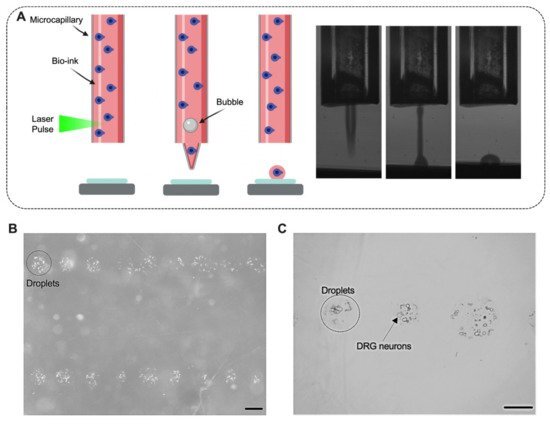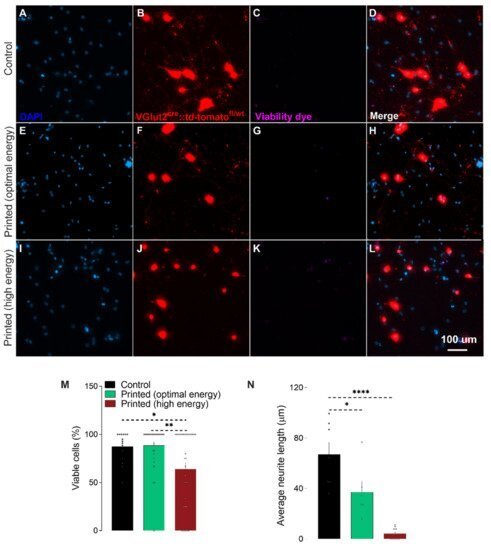The 2021 3D Printing Industry Awards shortlists are open for voting, have your say now.
A team of researchers from the University of Montréal, Concordia University and the Federal University of Santa Catarina has successfully 3D printed living mouse brain cells using a newly developed bioprinting technology.
The scientists used their Laser-Induced Side Transfer (LIST) technology to produce sensory neurons, a vital component of the peripheral nervous system, the majority of which remained alive two days after printing. The team ran several tests to measure the capacities of the printed cells, which they believe could help to significantly advance the field of bioprinting.
While the development is promising for bioprinting’s potential regarding disease modeling, drug testing, and implant fabrication, sci-fi-esque 3D printed brain organs and cell replacements remain a long way off.
“In general, people often leap to conclusions when we talking about bioprinting,” said Hamid Orimi, PhD student at Concordia University. “They think that we can now print things like human organs for transplants.
“While this is a long-term objective, we are very far from that point. But there are still many ways to use this technology.”
LIST printing brain cells
Laser-assisted bioprinting can support a wide range of bioink viscosities with little effect on cell viability and function, while maintaining high printing resolution and reproducibility. The scientist’s LIST bioprinting technology is a modified process for the laser bioprinting of cells which overcomes various limitations of other bioprinting techniques, such as donor preparation challenges, ink viscosity, and cell viability.
The process uses low-energy nanosecond laser pulses to generate a transient microbubble at the distal end of a glass microcapillary which is supplied with a bioink. As the microbubble expands, a cell-laden microjet droplet is ejected onto a substrate below. According to a previous study authored by Orimi, LIST could be adapted for applications requiring multiscale bioprinting such as 3D drug screening models and even artificial tissues.
During the current study, the research team sought to validate the feasibility of bioprinting adult sensory neurons using LIST. The scientists used dorsal root ganglion (DRG) neurons from the peripheral nervous system of mice to prepare the bioink. The neurons were then suspended in the bioink solution and loaded into a square capillary above a biocompatible substrate.
After being 3D bioprinted via the team’s LIST process, the samples were briefly incubated before being washed and re-incubated for 48 hours.

Assessing the 3D printed neurons
The team ran several tests to measure the 3D bioprinted cells’ capacities. A viability assessment found that 86 percent of the cells remained alive two days after printing, with viability rates improving when the laser used lower energy. As was to be expected, using a higher energy laser was found to be more likely to damage the cells.
Further tests measured neurite outgrowth, which refers to when developing neurons produce new projections as they grow in response to guidance cues, as well as neuropeptide release, calcium imaging and RNA sequencing.
The researchers observed that bioprinting did not impact the survival of the DRG neurons, but did reduce neurite outgrowth. The team also found that the 3D printed neurons maintained their ability to communicate with the cells of their environment by means of peptide release.
Ultimately, the results were generally encouraging, with the study showing that the LIST-printed adult sensory neurons maintained high viability and functional integrity. The scientists believe the technique could form an important contribution to the field of bioprinting, particularly within drug discovery and decreasing animal testing.
In the future, LIST bioprinting could potentially help pave the way for fewer animals to be euthanized in order to carry out experiments for human benefit, and could also produce more accurate results, since testing would be carried out on human tissue rather than that of animals.
Going forward, the team is seeking approval to continue their research into cell grafting, which they believe could greatly assist drug discovery, such as for nerve recovery medicines.
Further information on the study can be found in the paper titled: “Bioprinting of adult dorsal root ganglion (DRG) neurons using laser-induced side transfer (LIST)”, published in the Micromachines journal. The study is co-authored by K. Roversi, H. Orimi, M. Falchetti, E. Lummertz da Rocha, S. Talbot, and C. Boutopoulos.

3D printing brain cell advancements
Orimi and his team are not the only ones exploring the potential of 3D bioprinting to produce neural cells and structures.
Last year, a team of researchers from Tsinghua University 3D printed brain-like tissue structures capable of nurturing neural cells. After several weeks of in vitro nurturing, the initial neural cells had formed a complex neural circuit that could respond to external stimuli.
Elsewhere, medical tech company Fluicell teamed up with clinical R&D firm Cellectricon and the Karolinska Institutet to 3D bioprint neural cells into complex patterns using its Biopixlar platform. The partners were able to precisely arrange rat brain cells within 3D structures without damaging their viability, with the structures showing potential for modeling the progression of neurological diseases and drug development.
Most recently, researchers at the Chinese Academy of Sciences and the University of Science and Technology of China developed a novel bioprinting method for curing spinal cord injuries using a custom bioink. The bioink contained neural stem cell-loaded tissues capable of carrying instructions via impulses from the brain, and once implanted into rats were able to restore movement in paralyzed limbs.
Subscribe to the 3D Printing Industry newsletter for the latest news in additive manufacturing. You can also stay connected by following us on Twitter and liking us on Facebook.
Looking for a career in additive manufacturing? Visit 3D Printing Jobs for a selection of roles in the industry.
Subscribe to our YouTube channel for the latest 3D printing video shorts, reviews and webinar replays.
Featured image shows laser-induced side transfer (LIST) of neurons. Image via Micromachines.



